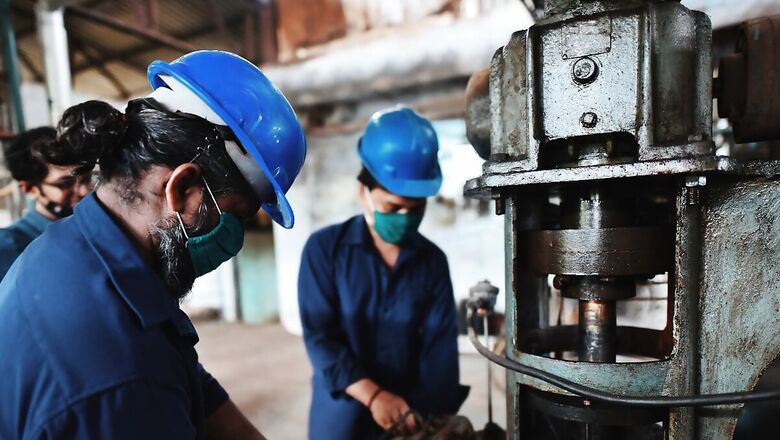
views
There has been a long-standing vision to make India a global manufacturing hub to create millions of jobs. However, considering India’s size and status as one of the world’s fastest-growing economies, it’s perplexing how the potential for job creation and growth in the manufacturing sector has been overlooked for so long.
The new government must implement a new industrial policy having decisive measures to address current structural constraints, and reshape India’s manufacturing sector in response to global supply chain shifts. This is crucial for achieving a GDP of $5 trillion and making India the world’s third-largest economy by 2027. It’s alarming that unemployment among young people with graduate degrees is at an all-time high of 29 per cent, even as India moves towards becoming the third-largest economy.
In 2019, manufacturing was the second-largest employer in India after agriculture, but it has now fallen to fourth place behind the construction sector, trade, and hospitality. The National Sample Survey Organisation (NSO) data shows that 45.5 per cent of the workforce is employed in agriculture, 12.4 per cent in construction, and only 11.6 per cent in manufacturing, despite its potential to create a multitude of job opportunities. Manufacturing still employs around 60 million people in India, however, effective action is needed to unlock its full potential for job creation at large.
India’s impressive growth is hindered by the lacklustre performance of the manufacturing sector, which has shown limited expansion over the past 25 years. Unlike other countries, India’s production structure has shifted directly from agriculture to services-driven growth, resulting in a stagnant contribution of manufacturing to India’s GDP at 15-17 per cent, significantly lower than in East and Southeast Asian countries. China has a 31.63 per cent share of global manufacturing, the US has 15.87 per cent, Japan 6.52 per cent, Germany 4.78 per cent, and India 2.87 per cent. This highlights the urgent need for India to address the challenges in its manufacturing sector.
The reasons for this stagnation could be diverse, such as high tax burden, over-burdened regulatory compliances, inadequate infrastructure and connectivity, unreliable electricity, lack of access to credit or a skilled workforce, and insufficient focus on research, development, and technology adoption. Despite these obstacles, Indian manufacturers are now more emboldened to transcend their comfort zones and align with the nation’s goal of becoming a global player.
Seven areas to be addressed
Focus on sectors of strength: There are strong capabilities in various sectors such as automobiles (especially e-vehicles, to raise its current share from 7 per cent to over 30 per cent), pharmaceuticals and chemicals, textiles and apparel, engineering goods, farm-implements, and bicycles. However, there are significant gaps in mega-scale facilities that can anchor large-scale exports. The reliability of supporting infrastructure and fostering global partnerships for MSMEs is critical for accelerating growth.
Revisit PLI: It is necessary to re-evaluate the effectiveness of the Production Linked Incentives (PLI) scheme, created in 2020 to invigorate the domestic manufacturing sector, and assess whether it is showing the desired results. The progress of schemes worth over Rs 2 lakh crore, covering 14 sectors, especially labour-intensive ones like automobiles, auto components, textiles, IT hardware, and medical devices, has been slow. The PLI scheme’s broader goals, such as job creation, attracting substantial investments, enhancing exports, and positioning India as a global manufacturing hub, have yet to be fulfilled.
Restructure GST: The current Goods and Service Tax (GST) structure applies to over 1250 items and services, with standard tax rates of 5, 12, and 18 per cent, and the highest rate of 28 per cent. Additionally, there are zero and special rates of 0.25, 1.5, and 3 per cent for certain goods and services. To address inflation and tax-related issues, a restructuring of the tax system is necessary. This could involve transitioning from the existing four-slab structure to a two-slab model and providing exemptions for items such as farm implements, which were previously exempted under the pre-GST regime.
Opportunities in next-generation sectors: Opportunities in renewable energy, aerospace, and high-tech manufacturing sectors such as semiconductors and mobile devices is a case in point as the $12 billion exports in FY23, more than double the $4.8 billion in FY20, are rapidly emerging as the world transitions to a green and connected future. Building a solid foundation in these sectors requires focusing on R&D, investments in technology transfers, global tie-ups, and incentivising investments, along with collaboration across academia, industry, and the government.
Smart manufacturing stack: India’s technology stack is a leading example of digital disruption at scale and showcases the country’s capabilities for innovative solutions. A similar innovative leap in manufacturing, oriented toward the next generation of smart industrial clusters, connected factories, enhanced efficiency and reduced waste, high-productivity assets, end-to-end value chain transparency, and tech-enabled real-time interventions, can be significant differentiators.
Accelerate future-ready infrastructure: India’s inefficiencies are costing the nation heavily in time and money. It is imperative to reduce current logistics costs from 8-10 per cent to 6 per cent of GDP by 2030. This requires a $1.2 billion investment in industry-focused corridors. To provide a level playing field to the manufacturing hubs in northern India, which are far from seaports, especially land-locked border states like Punjab, policy-backed support is needed to combat the more than double freight burden compared to southern and western states.
Labour-intensive manufacturing: As technological advancements drive productivity in manufacturing across various sectors, the government also needs to address the transition of the workforce from agriculture and other fields. The 2024 India Employment Report by the International Labour Organisation (ILO) emphasises the need to promote labour-intensive manufacturing and enhance efforts in skilling. It is crucial to prioritise skill development, and industry leaders should play a pivotal role in driving this initiative.
The Way Forward
A thriving and self-reliant domestic manufacturing sector is essential for India to achieve inclusive growth by implementing an aggressive and effective reform agenda and navigating geopolitical risks and climate change-driven calamities. It is crucial to ensure that the recent promises made in the polls are fulfilled to transform India into a global manufacturing hub, resulting in employment generation and tangible progress. India has the capacity and resources to excel in this area, and it’s time for the new government to make it happen.
The Author is Vice-Chairman of Sonalika ITL Group, Vice-Chairman (Cabinet minister rank) of the Punjab Economic Policy and Planning Board, Chairman of ASSOCHAM Northern Region Development Council and President of Tractor and Mechanization Association (TMA). Views expressed in the above piece are personal and solely that of the author. They do not necessarily reflect News18’s views.


















Comments
0 comment